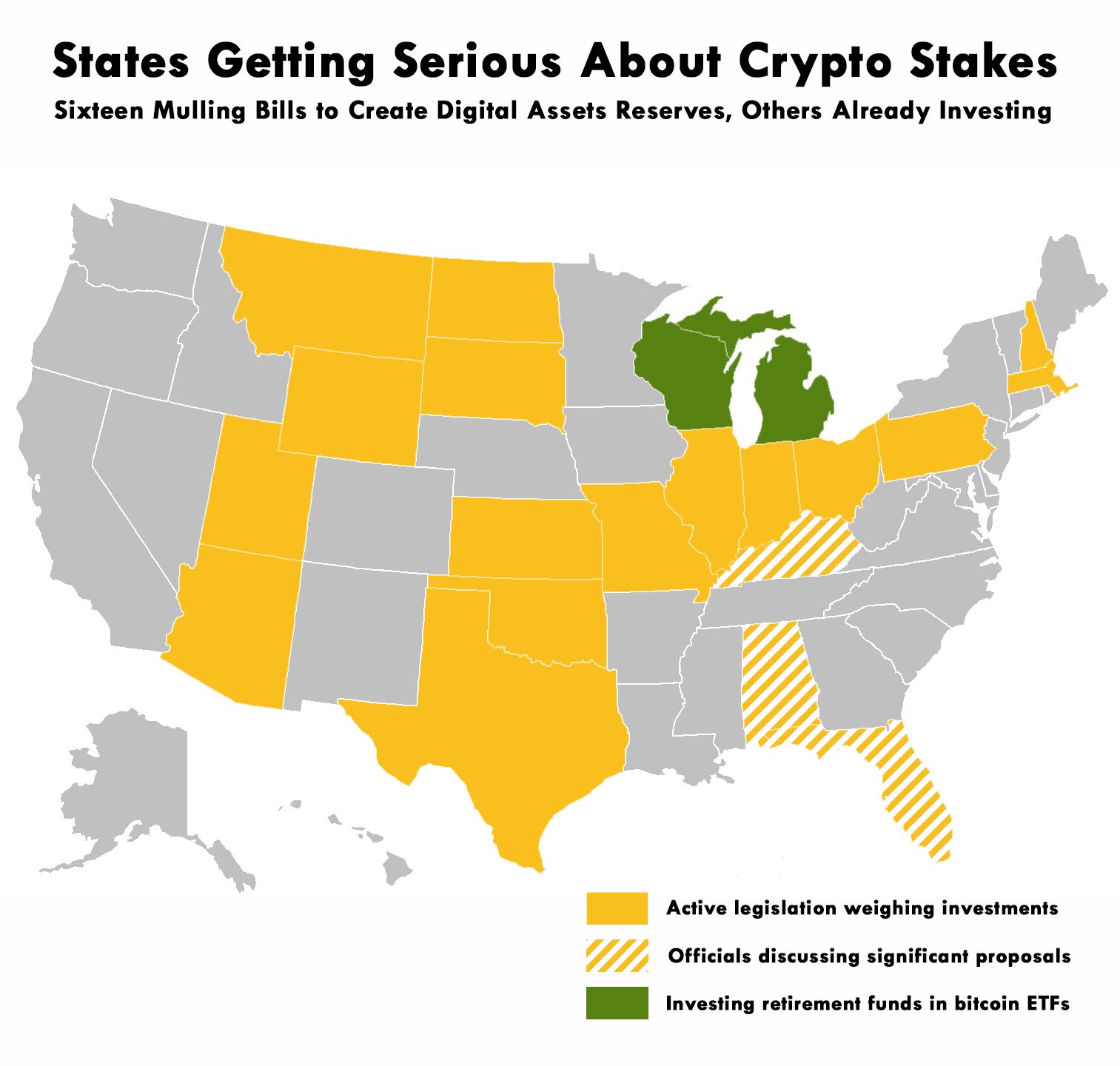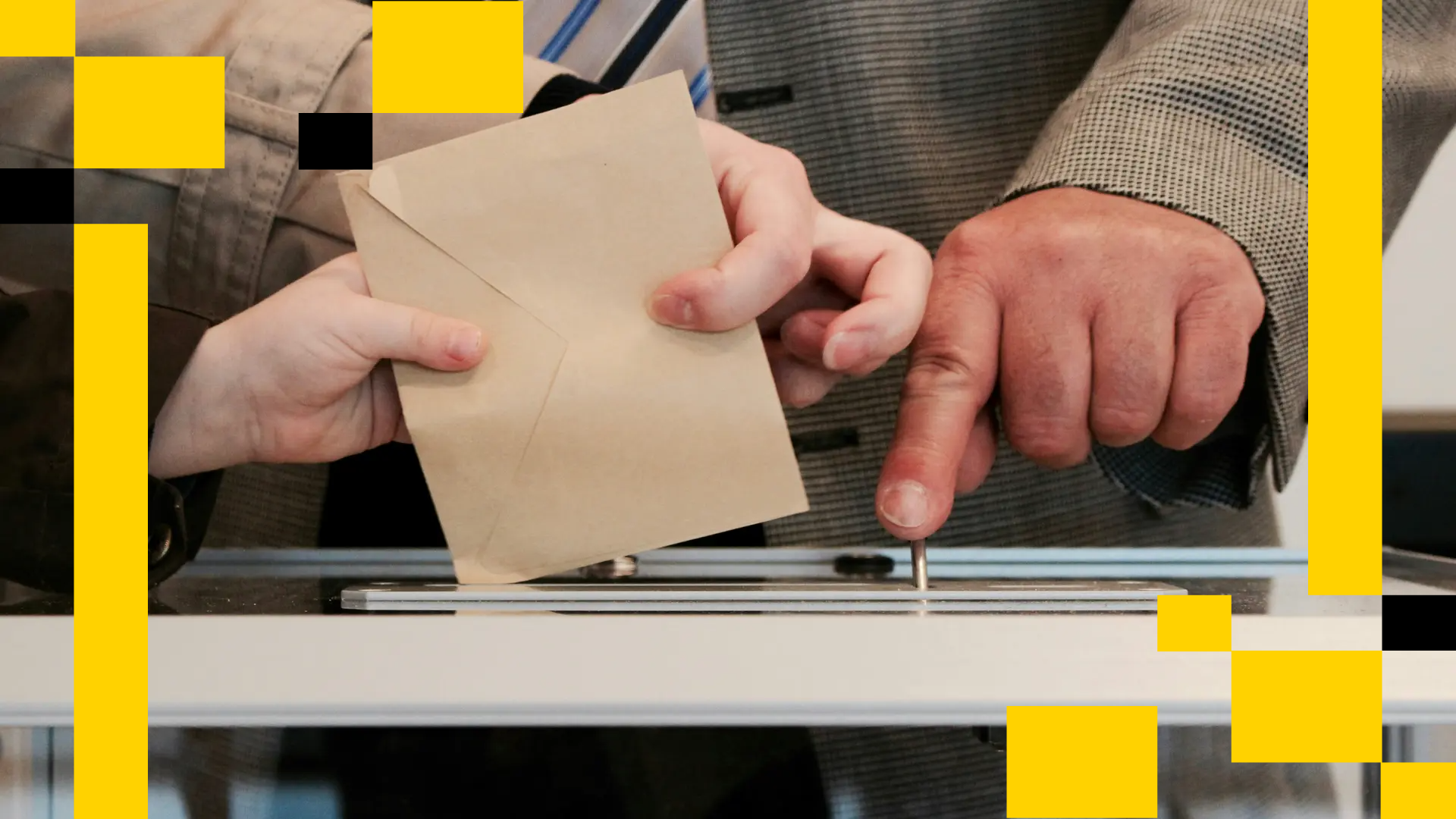Uncategorized
U.S. Bitcoin Reserve May Be Coming, But States Are Winning the Race

Almost half of the state governments in the U.S. are either on a path toward putting some of their money into crypto or already have, and much of a suddenly booming interest in tying their financial futures to the digital-assets markets has come after U.S. President Donald Trump showed support for a national stockpile of digit assets.
In the surge of crypto legislative or financial efforts at the state level, 21 states are investing or looking into investing — generally in the industry’s leading token, bitcoin (BTC), and sometimes also in less volatile stablecoins that are designed to match the value of the U.S. dollar, according to a CoinDesk analysis. With states such as Arizona, Pennsylvania, Utah and Texas already digging into legislation to open public funds to buy cryptocurrencies, such initiatives may outpace the effort in Congress targeting a so-called Strategic Bitcoin R
Sixteen state legislatures are looking at bills to either establish digital assets stockpiles or to allow their state retirement funds to be partially invested in crypto, most of them introduced in recent weeks. Officials in another three states are engaged in serious discussions about joining in, and the money managers for two states — Michigan and Wisconsin — have already dipped parts of their public employees’ retirement portfolios into crypto exchange-traded funds (ETFs).
If the states begin pouring portions of their public funds into bitcoin and other digital assets, it would potentially lock down billions of dollars of the tokens for extended periods, boosting the value of the assets still openly circulating. Another effect: The states are potentially setting up millions of people to have personal stakes in the health of the crypto sector — whether they want to or not.

In several of the proposals, governments are looking to follow in the footsteps of Michigan and Wisconsin in pushing parts of their retirement funds and state pension investments into digital assets. Retired school teachers, law enforcement officers and other public employees will watch some of their financial security become dependent on the fluctuations of the crypto markets.
Other pieces of legislation would instruct state treasurers to spend as much as 10% of their public funds on a strategic reserve, with some specifying that qualifying digital assets must have at least a $500 billion market cap, leaving only bitcoin currently meeting the mark.
Arizona and Utah are building a lead after getting their efforts passed by legislative committees, but other states weighing some version of a crypto bill also include Illinois, Indiana, Kansas, Massachusetts, Missouri, Montana, New Hampshire, North Dakota, Ohio, Oklahoma, South Dakota and Wyoming. Others, such as Alabama, Florida and Kentucky are considering proposals from state officials or on the verge of pursuing legislation. The states interested in digital assets reserves are predominantly Republican-majority in their politics, and the reasons the lawmakers say they’re backing the bills include investment diversity and embracing technological innovation.
The amount put away by the states could eventually be overshadowed by the U.S. government’s own reserve, if that effort comes to pass. President Trump, in his wider executive order on U.S. crypto policy, called for his administration to «evaluate the potential creation and maintenance of a national digital asset stockpile.» The order suggested it may be built from government seizures of crypto in criminal cases.
The idea had initially been pitched by Senator Cynthia Lummis, the Wyoming Republican who devotes much of her political bandwidth to supporting crypto and was named as the first chair of the Senate Banking Committee’s digital assets subcommittee. Her bill to set up a U.S. reserve calls for the country to obtain about $20 billion worth of the tokens in the first year and to get another 200,000 in each of the next four years, until the U.S. is eventually holding a million bitcoin.
While Lummis’ pitch has called it a «Strategic Bitcoin Reserve,» it’s not — like the petroleum reserve — designed for deployment when economic conditions warrant it. It’s structured more as a long-term investment, requiring the U.S. to hold the assets for at least 20 years.
That would be almost 5% of the eventual, finite supply of global bitcoin going untouched for at least two decades. Combined with whatever the states seek to stockpile, U.S. governments would secure a significant percentage of the asset, in addition to the towering reserves held by the U.S. ETF issuers such as BlackRock and Grayscale and corporate investors led by MicroStrategy.
The states’ interest in bitcoin potentially lands Satoshi Nakamoto’s ultimate exercise of financial outsiders firmly in the realm of the insiders, adding the asset to the core functions of government. The Bitcoin white paper meant to establish a system of transactions outside of the need of financial-firm intermediaries or government oversight.
States setting up bitcoin funds managed in part by new laws could become some of the most stable of the industry’s institutional investors. And naming bitcoin as a «strategic reserve» puts the digital tokens on par with gold and oil as economic mainstays, despite the very different nature of cryptocurrencies and their practical weaknesses as an inflation hedge.
From the perspective of their citizens or public employees, states that grab crypto stakes will come away with two potential outcomes: Millions of people will enjoy more comfortable and well-funded retirements or public services; or millions of people will watch a crypto crash eat into the safety net they’re counting on.
It could be «disastrous for tens of millions of retirees if government officials gambled with state pension funds to buy bitcoin or crypto,» said Dennis Kelleher, CEO of Better Markets, a Washington-based advocacy group that’s critical of the dangers of digital assets.
He called the idea of a government bitcoin stockpile «a brazen attempt by a handful of crypto billionaires and their political allies to take money out of Main Street taxpayers’ pockets to create artificial demand for a highly volatile product that suffers from boom-bust cycles, is full of fraudulent trading and pricing in unregulated markets, and has no socially legitimate use, but is loved by criminals.»
Wagers on the prediction site Polymarket have put the odds of one of the states beginning to set aside bitcoin reserves before the end of this month at 11%, and the chances of the U.S. setting up such a reserve this year at the national level are at 45%.
It may already be a trend that governments around the world can’t ignore.
«We anticipate more nation-states, central banks, sovereign wealth funds, and government treasuries will look to establish strategic positions in bitcoin,» Fidelity Digital Assets researchers predicted in a look-ahead report for 2025. «Facing challenges such as debilitating inflation, currency debasement, and increasingly crushing fiscal deficits, not making any bitcoin allocation could become more of a risk to nations than making one.»
Uncategorized
Bank of England’s Proposed Stablecoin Ownership Limits are Unworkable, Says Crypto Group

The Financial Times (FT) reported on Monday that cryptocurrency groups are urging the Bank of England (BoE) to scrap proposals limiting the amount of stablecoins individuals and businesses can own.
The group warned that the rules would leave the UK with stricter oversight than the U.S. or the European Union (EU).
According to the FT, BoE officials plan to impose caps of 10,000 british pounds to 20,000 british pounds ($13,600–$27,200) for individuals and about 10 million british pounds ($13.6 million) for businesses on all systemic stablecoins, defined as tokens already widely used for payments in the U.K. or expected to be in the future.
The central bank has argued the restrictions are needed to prevent outflows of deposits from banks that could weaken credit provision and financial stability.
The FT cited Sasha Mills, the BoE’s executive director for financial market infrastructure, as saying the limits would mitigate risks from sudden deposit withdrawals and the scaling of new systemic payment systems.
However, industry executives told the FT the plan is unworkable.
Tom Duff Gordon, Coinbase’s vice president of international policy, said “imposing caps on stablecoins is bad for U.K. savers, bad for the City and bad for sterling,” adding that no other major jurisdiction has imposed such limits.
Simon Jennings of the UK cryptoasset business council said enforcement would be nearly impossible without new systems such as digital IDs. Riccardo Tordera-Ricchi of The Payments Association told the FT that limits “make no sense” because there are no caps on cash or bank accounts.
The U.S. enacted the GENIUS Act in July, which establishes a federal framework for payment stablecoins. The law sets licensing, reserve and redemption standards for issuers, with no caps on individual holdings. The European Union has also moved ahead with its Markets in Crypto-Assets Regulation (MiCA), which is now fully in effect across the bloc.
Stablecoin-specific rules for asset-referenced and e-money tokens took effect on June 30, 2024, followed by broader provisions for crypto-assets and service providers on Dec. 30, 2024. Like the U.S. approach, MiCA does not cap holdings, instead focusing on reserves, governance and oversight by national regulators.
Uncategorized
What’s Next for Bitcoin and Ether as Downside Fears Ease Ahead of Fed Rate Cut?

Fears of a downside for bitcoin (BTC) and ether (ETH) have eased substantially, according to the latest options market data. However, the pace of the next upward move in these cryptocurrencies will largely hinge on the magnitude of the anticipated Fed rate cut scheduled for Sept. 17.
BTC’s seven-day call/put skew, which measures how implied volatility is distributed across calls versus puts expiring in a week, has recovered to nearly zero from the bearish 4% a week ago, according to data source Amberdata.
The 30- and 60-day option skews, though still slightly negative, have rebounded from last week’s lows, signaling a notable easing of downside fears. Ether’s options skew is exhibiting a similar pattern at the time of writing.
The skew shows the market’s directional bias, or the extent to which traders are more concerned about prices rising or falling. A positive skew suggests a bias towards calls or bullish option plays, while a negative reading indicates relatively higher demand for put options or downside protection.
The reset in options comes as bitcoin and ether prices see a renewed upswing in the lead-up to Wednesday’s Fed rate decision, where the central bank is widely expected to cut rates and lay the groundwork for additional easing over the coming months. BTC has gained over 4% to over $116,000 in seven days, with ether rising nearly 8% to $4,650, according to CoinDesk data.
What happens next largely depends on the size of the impending Fed rate cut. According to CME’s Fed funds futures, traders have priced in over 90% probability that the central bank will cut rates by 25 basis points (bps) to 4%-4.25%. But there is also a slight possibility of a jumbo 50 bps move.
BTC could go berserk in case the Fed delivers the surprise 50 bps move.
«A surprise 50 bps rate cut would be a massive +gamma BUY signal for ETH, SOL and BTC,» Greg Magadini, director of derivatives at Amberdata, said in an email. «Gold will go absolutely nuts as well.»
Note that the Deribit-listed SOL options already exhibit a strong bullish sentiment, with calls trading at 4-5 volatility premium to puts.
Magadini explained that if the decision comes in line with expectations for a 25 bps cut, then a continued calm «grind higher» for BTC looks likely. ETH, meanwhile, may take another week or so to retest all-time highs and convincingly trade above $5,000, he added.
Uncategorized
Asia Morning Briefing: Native Markets Wins Right to Issue USDH After Validator Vote

Good Morning, Asia. Here’s what’s making news in the markets:
Welcome to Asia Morning Briefing, a daily summary of top stories during U.S. hours and an overview of market moves and analysis. For a detailed overview of U.S. markets, see CoinDesk’s Crypto Daybook Americas.
Hyperliquid’s validator community has chosen Native Markets to issue USDH, ending a weeklong contest that drew proposals from Paxos, Frax, Sky (ex-MakerDAO), Agora, and others.
Native Markets, co-founded by former Uniswap Labs president MC Lader, researcher Anish Agnihotri, and early Hyperliquid backer Max Fiege, said it will begin rolling out USDH “within days,” according to a post by Fiege on X.
According to onchain trackers, Native Markets’ proposal took approximately 70% of validators’ votes, while Paxos took 20%, and Ethena came in at 3.2%.
The staged launch starts with capped mints and redemptions, followed by a USDH/USDC spot pair before caps are lifted.
USDH is designed to challenge Circle’s USDC, which currently dominates Hyperliquid with nearly $6 billion in deposits, or about 7.5% of its supply. USDC and other stablecoins will remain supported if they meet liquidity and HYPE staking requirements.
Most rival bidders had promised to channel stablecoin yields back to the ecosystem with Paxos via HYPE buybacks, Frax through direct user yield, and Sky with a 4.85% savings rate plus a $25 million “Genesis Star” project.
Native Markets’ pitch instead stressed credibility, trading experience, and validator alignment.
Market Movement
BTC: BTC has recently reclaimed the $115,000 level, helped by inflows into ETFs, easing U.S. inflation data, and growing expectations for interest rate cuts. Also, technical momentum is picking up, though resistance sits around $116,000, according to CoinDesk’s market insights bot.
ETH: ETH is trading above $4600. The price is being buoyed by strong ETF inflows.
Gold: Gold continues to trade near record highs as traders eye dollar weakness on expected Fed rate cuts.
Elsewhere in Crypto:
-

 Business11 месяцев ago
Business11 месяцев ago3 Ways to make your business presentation more relatable
-

 Fashion11 месяцев ago
Fashion11 месяцев agoAccording to Dior Couture, this taboo fashion accessory is back
-

 Entertainment11 месяцев ago
Entertainment11 месяцев ago10 Artists who retired from music and made a comeback
-

 Entertainment11 месяцев ago
Entertainment11 месяцев ago\’Better Call Saul\’ has been renewed for a fourth season
-

 Entertainment11 месяцев ago
Entertainment11 месяцев agoNew Season 8 Walking Dead trailer flashes forward in time
-

 Business11 месяцев ago
Business11 месяцев ago15 Habits that could be hurting your business relationships
-

 Entertainment11 месяцев ago
Entertainment11 месяцев agoMeet Superman\’s grandfather in new trailer for Krypton
-

 Entertainment11 месяцев ago
Entertainment11 месяцев agoDisney\’s live-action Aladdin finally finds its stars





